Schemes for connecting a water heater to a water supply: how to avoid making mistakes when installing a boiler
Installing a water heater will provide owners of country houses with hot water and will increase the comfort of apartments from the old housing stock such as Khrushchev-era buildings and small-family dormitories.The tireless unit will diligently prepare and supply water to the taps so that the owners can enjoy the benefits of civilization.
This will happen if the diagrams for connecting the water heater to the water supply were followed exactly, don’t you agree? You will find complete answers to a wide range of questions that arise before installing water heaters and in the process of connecting them to the communication network on our website.
Reliable information will be useful to independent craftsmen who want to carry out the installation themselves. It is also necessary for customers of plumbing services to check the quality of the work.
The article describes in detail the types of water heaters, indicates their design differences, and indicates the specifics of the connection. Valuable tips are provided to ensure perfect operation of the equipment after installation. The information content of the proposed material is perfectly complemented by photographs and video recommendations.
The content of the article:
Types of domestic water heaters
Features of connecting household heaters are directly related to the types of devices, their technical parameters, and overall dimensions.
Traditionally, in everyday practice there are two type of heaters:
- Cumulative.
- Flow-through.
Both types of boiler systems differ from each other in heating technology.
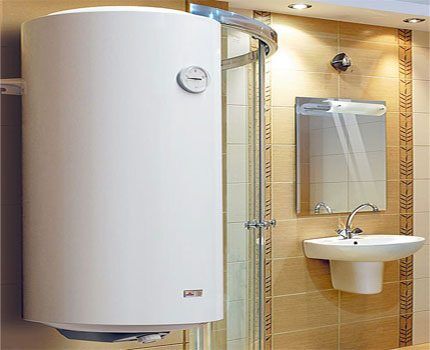
Storage heaters cold water is collected in a container, heated and then discharged for tapping.
Flow units heating is carried out directly during the flow of cold water in contact with the heater, without collecting liquid in a storage tank.
Household consumers mainly use storage boiler systems. A comparative overview of both types of water heaters is given in this article.
Technical device of the storage boiler
A storage-type water heating system, boilers, in a simplified schematic form is a container equipped with electric heating elements or liquid heat exchangers. The storage vessel has pipe lines for cold water supply and hot water outlet.
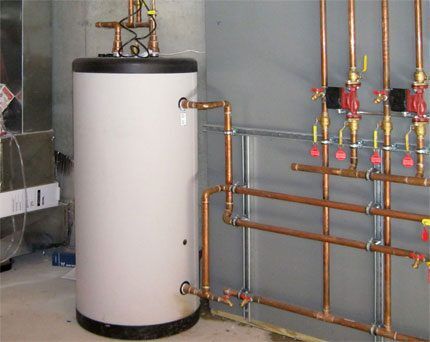
Constructions indirect heating boilers are additionally equipped with a working coolant area and heating connection lines.
Any modern system, regardless of its design features, is equipped with automation, thanks to which the water heating temperature and the operation of the system as a whole are regulated.
Structural design of heating devices
Exist storage boiler designs designed for installation vertically (wall-mounted) and horizontally (floor-mounted). Of course, each individual case of using certain boilers has its own installation features.
So, if it is planned to install a water heating device on a wall, a preliminary calculation of the load and comparison of the results obtained with the design parameters of the wall of the room on which the device is to be mounted is necessary.
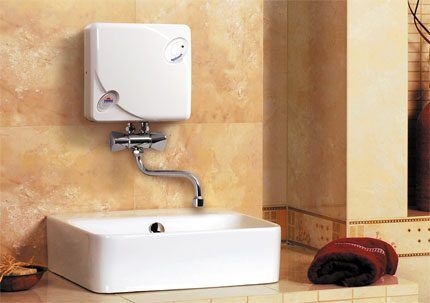
Installing equipment without load calculations threatens to result in a fatal installation error, when a filled boiler can simply collapse along with the flimsy partition on which it was mounted.
According to the equipment instructions, the load must be calculated taking into account four times the weight of the boiler system.
Therefore, if the structure of the supporting wall is frankly weak, the water heater circuit must be supplemented not only with connection lines to the water supply and coolant, but also with reinforced racks - through fasteners.
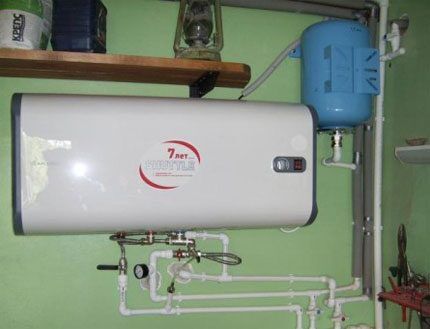
In classic connection diagrams for wall-mounted boilers, the water supply/discharge pipes of heating devices are marked with the appropriate color - blue/red.
Installation diagrams and solutions
You can connect a heating device to the centralized supply in one of two ways: through a security group or directly.
A security group consists of a collection of the following elements:
- shut-off valve;
- Check Valve;
- safety valve;
- expansion vessel.
Option #1. The presence of a safety group is traditionally used in indirect heating boiler installations, and also when central system pressure above the boiler operating pressure limit.
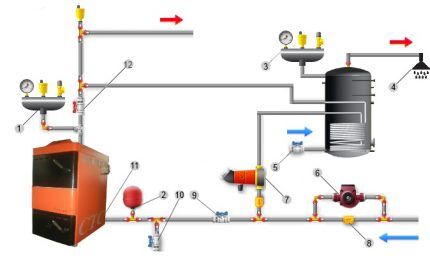
Option No. 2. Direct connection is usually applicable to small-capacity equipment with a flow-through operating principle. Direct connection is also allowed in conditions of lower and stable pressures of the centralized water supply. In any case, the installation diagram involves the installation of shut-off valves.
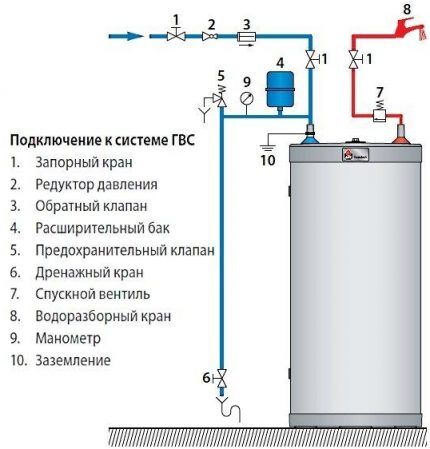
Criteria for error-free installation of equipment
Among the main installation points that you should pay attention to in order not to make mistakes are the correspondence of the diameters of the pipelines in relation to the inlet fittings, as well as the cross-section of the cable supplying the electric heater of the boiler.
The diameter of the supply pipes must ensure free flow of water along the inlet/outlet lines. Therefore, a larger diameter of hoses with a transition to the size of the fittings is still acceptable, but a cross-section of pipelines that is smaller than the inlet pipes of the boiler already seems to be a gross mistake.
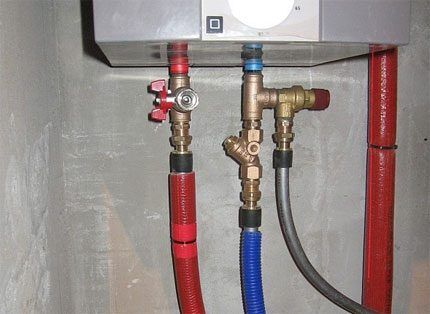
The cross-section of the power cable shows a similar picture. It is not prohibited to use a cable with a larger cross-section, but it is strictly prohibited to use a cable with a smaller cross-section.
True, a cable with a larger cross-section than the norm creates difficulties when laying in channels and takes up more free space. Here it seems logical to accurately selection of wire cross-section depending on the load current.
The power socket is usually mounted directly next to the device. The installation height of the socket from the floor level is not less than 1.5 m. Household boilers are designed for power supply with single-phase alternating current 220-250 W. The current load is usually at least 10 A.
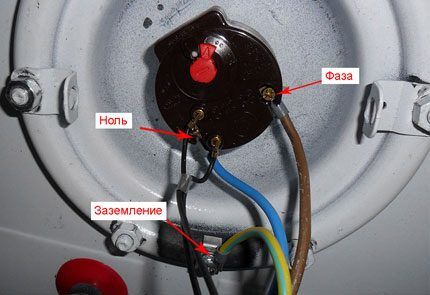
The exact value is determined by the performance of the heater and is indicated in the technical documentation. It is for the specified current value that the circuit breaker must be selected.
For example, for flow-through heaters, the following current cut-off standards for automatic machines are relevant (table):
| Boiler power (flow circuit), kW | Circuit breaker current, A |
| 3,5 | 20 |
| 5,5 | 25 |
| 6,5 | 30 |
As a rule, all required connection parameters are specified in the instructions for the boiler. The user manual explains exactly all aspects of installation. Therefore, it is recommended that you carefully study the documents included with the device before installation.
Some features of the water supply scheme
Connecting a storage boiler. Cold water is supplied to the boiler system through a pipeline that is connected directly to the centralized supply riser.
In this case, a number of components necessary for the normal functioning of the equipment are installed on the cold water line:
- Stopcock.
- Filter (not always).
- Safety valve.
- Drain tap.
The indicated circuit elements are installed in the area between the cold water supply pipe and the boiler in the marked sequence.
The line for the outlet of heated liquid is also equipped with a shut-off valve by default. However, this requirement is not mandatory and if a tap is not installed at the DHW outlet, a serious mistake is not seen in this.
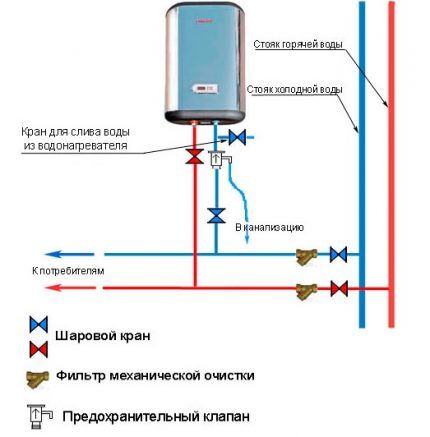
Connecting an instantaneous water heater. Compared to a storage boiler, the work is carried out according to a simplified scheme. Here it is enough to install only one shut-off valve in front of the cold water inlet fitting.
But the installation of a shut-off valve at the DHW outlet of a flow-through heater is considered by many manufacturers to be a gross installation error.
You should also take into account: if the source of cold water supply for an instantaneous water heater is a well, a well, a water tower, etc., it is recommended to turn it on in series with the tap (after the tap). coarse filter.
Often, an installation error with connecting the filter or refusal to install it leads to loss of the manufacturer’s warranty.
Common mistakes in installing water heaters
The installation rules for such equipment provide for the use of insulation on cold water/hot water pipelines. In this case, the technical requirements for installation determine the minimum possible size of insulation thickness - 20 mm.
The level of thermal conductivity of the insulating material must be at least – 0.035 W/m2.
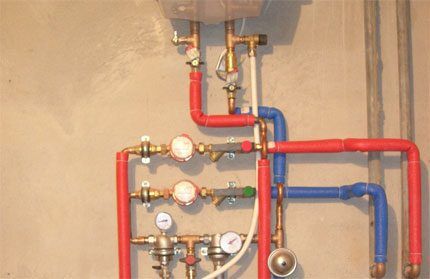
When installing water heaters, they often violate the connection diagram of the home unit to the water supply, using thin insulating material, or not using insulation at all.
As a result, when full operation of the device begins, significant losses of thermal energy are noted. These losses are reflected in the heating time, which increases significantly.
Improper or missing insulation is the main cause of condensation on the cold water line. This state of the system reduces the level of user comfort and contributes to the formation of an unsanitary environment inside the premises where the equipment is located.
A common mistake is to install a boiler without an expansion vessel. The scheme, which provides for the introduction of an expansion vessel, is relevant specifically for storage-type water heaters.
Thanks to the expansion vessel, it is possible to compensate for the increase in pressure caused by the increase in the volume of water in the boiler storage tank.

As a rule, the installation of storage type heaters is limited to the inclusion of a safety valve in the cold water main section.This kind of replacement of the expansion tank with a safety valve is acceptable, but, from the point of view of proper installation, this is a technical error.
In fact, on storage boilers you should always install an expansion vessel along with a check valve.
List of other installation errors:
- the electrical cable is laid on sharp metal edges or on high-temperature surfaces;
- the order of connecting the main lines does not correspond to the order indicated on the diagram;
- the level of installation of the water heater relative to the horizontal and vertical is violated;
- there is no grounding circuit for the water heating device;
- the parameters of the electrical network to which the equipment is connected do not meet the passport requirements;
- installation is carried out in a room where there is no water supply and drainage system.
Any, even insignificant, error in installing water heating equipment can play a fatal role after the device starts operating.
We invite you to familiarize yourself with detailed instructions for installing a storage and instantaneous water heater:
- Do-it-yourself storage water heater installation: step-by-step guide + technical standards
- Do-it-yourself instantaneous water heater installation: step-by-step instructions
Conclusions and useful video on the topic
The operation of the hot water supply and heating system depends on the correct installation of water heating devices, so it is important to take into account all installation nuances. Several practical tips are presented in the videos.
Professional Tips:
Recommendations for self-installation:
It is always recommended to carefully monitor the progress of installation work, guided by the accompanying documentation for the installation of a specific boiler model.
Often, users install the system without bothering to look at the attached diagram. Connecting two water pipes and inserting a plug into a socket - such actions seem commonplace for them. But technology does not forgive mistakes.
Do you have personal experience installing and connecting a water heater? Do you want to share your accumulated knowledge or ask questions on the topic? Please leave comments and participate in discussions - the feedback form is located below.




A 20 liter storage water heater has been installed for a couple of years now. Hangs on the wall, I connected it myself with the help of my brother. This is my second experience. I myself connected the first heater incorrectly without an expansion vessel, so due to pressure and improper operation, one day it just started leaking wildly, and I had to urgently replace it. If you are not sure, it is better to call at least someone with installation experience.
Last month, as always happens in the summer, the hot water had to be turned off. There was an announcement, we were mentally preparing for this. But on the scheduled day, the water from the hot tap continued to flow at normal temperature. We did not become indignant... After talking with the neighbors on the site, we found out that they did not have hot water! We discussed why ours was leaking - and the neighbor said that, most likely, someone on our riser installed the water heater incorrectly, and it supplies the entire riser with hot water. We plan to purchase and install our heater this month.Tell me how not to follow the path of that neighbor who screwed up the installation? What should you pay attention to? I'm not greedy, but I don't want to pay for heating water for all the neighbors on the riser...
Why would you install a boiler to heat water if your neighbor now supplies it for free? Just kidding, of course, sooner or later this “holiday” will end.
The most common reason that people provide free hot water to their neighbors is to tap into the current hot water supply. At the same time, people forget to turn off the valve, which blocks the water supply. Accordingly, after connecting the heating boiler, the supply of hot water in the opposite direction begins.
If there are several such valves, then they all need to be closed. In this case, it happens that this is impossible to do (the design is outdated), then you just have to weld or change the valves to working ones. The last option is relevant if you plan to use hot water from the boiler room in winter, and from your boiler in summer.
My biggest mistake when installing a boiler is not installing a water drain valve on top of the return line. This is truly sad, especially when it’s time to change the anode or heating element or all together, you have to unscrew the connections and drain the water while standing with a bucket for 30-40 minutes, despite the fact that the boiler is 50 liters. Now, don't do that. Otherwise, installation does not cause any difficulties.